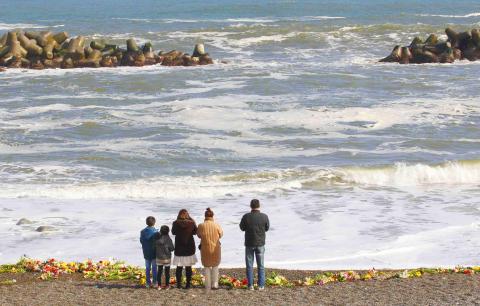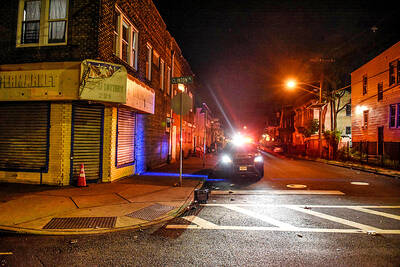As cold northerly winds sprinkle the first snow on the mountains surrounding the medieval Japanese city of Okuma, those who fled the city after last year’s disaster at the Fukushima Dai-ichi nuclear power plant are losing hope of ever returning to their homes.
Okuma lies close to the power plant and was hastily evacuated when a huge earthquake and tsunami crippled the power plant on March 11 last year.
Okuma Mayor Toshitsuna Watanabe has vowed to lead residents back home as soon as radiation levels are low enough. Yet the slow pace of the Japanese government’s cleanup efforts and the risk of another leak from the plant’s reactors has forced city officials to admit in September that resettlement might not happen for at least a decade.

Photo: Reuters
A growing number of Okuma evacuees are pessimistic about ever living there again. At a temporary housing complex in Aizu-Wakamatsu, a city 97km west of the plant, the mostly elderly residents say they do not have much time or energy left to rebuild their town.
Many said they preferred plans that got them out of temporary housing, but helped them maintain the friendships and communal bonds built over a lifetime, such as rebuilding the town farther away from the plant.
“I was one of those who kept saying: ‘We will go back, we will go back!’” said Toshiko Iida, 78, who left her rice farm behind. “Now, they are saying it will be years before we can go back. I’ll be dead then.”
Such feelings of resignation are shared by many of the 159,000 people who fled their towns after the triple meltdown at the Fukushima plant.
After first being reassured by the authorities that the accident was not so bad, then encouraged as the costly decontamination effort began, many evacuees are finally accepting that it may take decades, perhaps generations, before their town could be anything like it was before the disaster.
“We all want to go back, but we have to face the obvious,” said Koichi Soga, 75, a retired carpenter.
Such sentiments have led to a very public loss of hope by the 11,350 displaced residents of Okuma, one of nine communities within 19.3km of the stricken plant that were evacuated.
After living shelters for about a month, Okuma Town Hall officials and about 4,300 of its residents relocated to temporary sites in Aizu-Wakamatsu, with the rest scattered as far as Tokyo.
Watanabe, 65, immediately began drawing up plans for returning to Okuma that called for a group to resettle a small corner of the town where radiation levels were relatively low. The settlers would then slowly expand the livable areas, decontaminating one street or building at a time, like colonists reclaiming a post-apocalyptic wilderness.
In fall last year, the plan won de facto approval when Okuma residents re-elected Watanabe over a challenger who had called for building a new town at a safer location. Hopes were still high early this year when the Japanese Ministry of the Environment began a decontamination program — with a budget of US$4.8 billion for this year alone — that employed a small army of workers to scrape away top soil, denude trees of branches and scrub down buildings in Okuma and other evacuated communities.
However, the ministry said this summer that an experimental effort to decontaminate a 17 hectare area in Okuma had failed to reduce radiation dosages by as much as had been hoped, leading officials to declare most of the town uninhabitable for at least another five years. That forced Okuma’s officials to change the target date of their “road map” for repopulating the town to 2022, instead of 2014.
“People are giving up because we have been hit by negative news after negative news,” said Watanabe, who set up a temporary town hall in a former girls’ high school on a corner of Aizu-Wakamatsu’s six-century-old castle. “Keeping our road map is the only way to hold onto hope and prevent the town from disappearing.”
Watanabe admits that his plan has a dwindling number of adherents. A questionnaire sent to Okuma’s evacuees by the town hall in September found that only 11 percent of the 3,424 households that responded said they wanted to go back, while 45.6 percent said they had no intention of ever returning, mostly because of radiation fears.
Hopes for a return took another blow early this month when ministry officials told Watanabe that they planned to build as many as nine temporary storage facilities in Okuma for dirt and other debris from the cleanup. Many evacuees said they did not want to go back if their town was to be used as a dumping ground for radioactive refuse.
At the temporary housing site, where prefabricated apartments stood in rows like barracks on a former soccer field, many evacuees said they had been allowed to return to their homes in Okuma wearing hazmat suits and masks on tightly monitored, one-hour visits to retrieve some belongings. Many said that as the months passed, it was becoming more emotionally difficult to think about spending the time and energy to rebuild.
“Every time I go back, it feels less and less like my home,” 85-year-old Hiroko Izumi said.
Many others said the town needed to move fast to keep its relatively small number of working-age residents, who were already beginning to find jobs and start new lives in places like Aizu-Wakamatsu.
“If too much time passes, Okuma could just disappear,” healthcare worker Harue Soga, 63, said.
For those who do not want to move back, Okuma drew up an alternative plan in September that calls for building a new town on vacant land safely outside the evacuation zone around the plant. The new town would be built within five years.
Watanabe admits that he is now among a minority of former residents who are still determined to go back to the original Okuma.
He describes an almost spiritual attachment to the land where his family has grown rice for at least 19 generations and that holds the family graves that Confucian tradition forbids him from abandoning.
“We have been living there for 1,000 years,” he said. “I have promised myself that one day, I will again eat my own rice grown on my ancestral farm.”

DOUBLE-MURDER CASE: The officer told the dispatcher he would check the locations of the callers, but instead headed to a pizzeria, remaining there for about an hour A New Jersey officer has been charged with misconduct after prosecutors said he did not quickly respond to and properly investigate reports of a shooting that turned out to be a double murder, instead allegedly stopping at an ATM and pizzeria. Franklin Township Police Sergeant Kevin Bollaro was the on-duty officer on the evening of Aug. 1, when police received 911 calls reporting gunshots and screaming in Pittstown, about 96km from Manhattan in central New Jersey, Hunterdon County Prosecutor Renee Robeson’s office said. However, rather than responding immediately, prosecutors said GPS data and surveillance video showed Bollaro drove about 3km

Tens of thousands of people on Saturday took to the streets of Spain’s eastern city of Valencia to mark the first anniversary of floods that killed 229 people and to denounce the handling of the disaster. Demonstrators, many carrying photos of the victims, called on regional government head Carlos Mazon to resign over what they said was the slow response to one of Europe’s deadliest natural disasters in decades. “People are still really angry,” said Rosa Cerros, a 42-year-old government worker who took part with her husband and two young daughters. “Why weren’t people evacuated? Its incomprehensible,” she said. Mazon’s

‘MOTHER’ OF THAILAND: In her glamorous heyday in the 1960s, former Thai queen Sirikit mingled with US presidents and superstars such as Elvis Presley The year-long funeral ceremony of former Thai queen Sirikit started yesterday, with grieving royalists set to salute the procession bringing her body to lie in state at Bangkok’s Grand Palace. Members of the royal family are venerated in Thailand, treated by many as semi-divine figures, and lavished with glowing media coverage and gold-adorned portraits hanging in public spaces and private homes nationwide. Sirikit, the mother of Thai King Vajiralongkorn and widow of the nation’s longest-reigning monarch, died late on Friday at the age of 93. Black-and-white tributes to the royal matriarch are being beamed onto towering digital advertizing billboards, on

POWER ABUSE WORRY: Some people warned that the broad language of the treaty could lead to overreach by authorities and enable the repression of government critics Countries signed their first UN treaty targeting cybercrime in Hanoi yesterday, despite opposition from an unlikely band of tech companies and rights groups warning of expanded state surveillance. The new global legal framework aims to bolster international cooperation to fight digital crimes, from child pornography to transnational cyberscams and money laundering. More than 60 countries signed the declaration, which means it would go into force once ratified by those states. UN Secretary-General Antonio Guterres described the signing as an “important milestone,” and that it was “only the beginning.” “Every day, sophisticated scams destroy families, steal migrants and drain billions of dollars from our economy...